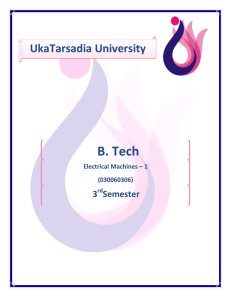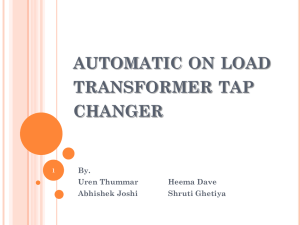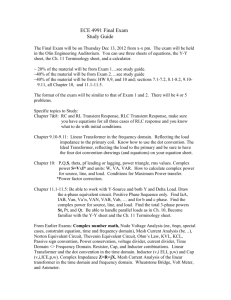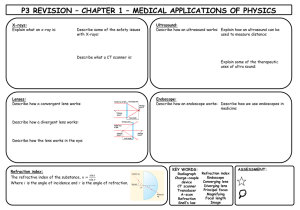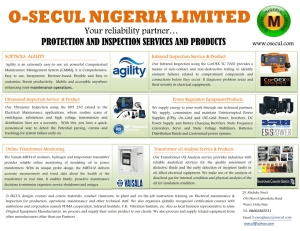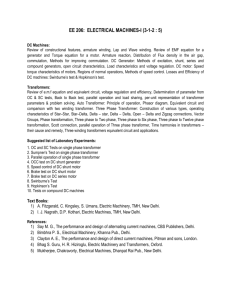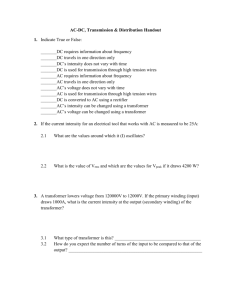Transformer Manufacturers in Malaysia: Perspective In
advertisement
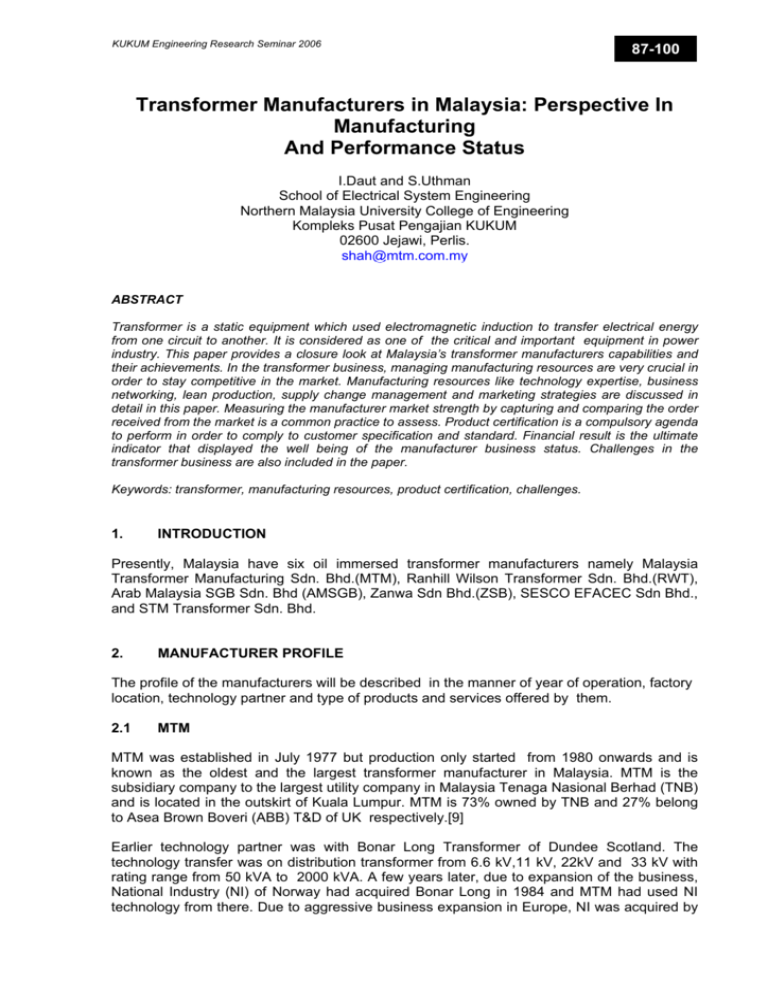
KUKUM Engineering Research Seminar 2006 87-100 Transformer Manufacturers in Malaysia: Perspective In Manufacturing And Performance Status I.Daut and S.Uthman School of Electrical System Engineering Northern Malaysia University College of Engineering Kompleks Pusat Pengajian KUKUM 02600 Jejawi, Perlis. shah@mtm.com.my ABSTRACT Transformer is a static equipment which used electromagnetic induction to transfer electrical energy from one circuit to another. It is considered as one of the critical and important equipment in power industry. This paper provides a closure look at Malaysia’s transformer manufacturers capabilities and their achievements. In the transformer business, managing manufacturing resources are very crucial in order to stay competitive in the market. Manufacturing resources like technology expertise, business networking, lean production, supply change management and marketing strategies are discussed in detail in this paper. Measuring the manufacturer market strength by capturing and comparing the order received from the market is a common practice to assess. Product certification is a compulsory agenda to perform in order to comply to customer specification and standard. Financial result is the ultimate indicator that displayed the well being of the manufacturer business status. Challenges in the transformer business are also included in the paper. Keywords: transformer, manufacturing resources, product certification, challenges. 1. INTRODUCTION Presently, Malaysia have six oil immersed transformer manufacturers namely Malaysia Transformer Manufacturing Sdn. Bhd.(MTM), Ranhill Wilson Transformer Sdn. Bhd.(RWT), Arab Malaysia SGB Sdn. Bhd (AMSGB), Zanwa Sdn Bhd.(ZSB), SESCO EFACEC Sdn Bhd., and STM Transformer Sdn. Bhd. 2. MANUFACTURER PROFILE The profile of the manufacturers will be described in the manner of year of operation, factory location, technology partner and type of products and services offered by them. 2.1 MTM MTM was established in July 1977 but production only started from 1980 onwards and is known as the oldest and the largest transformer manufacturer in Malaysia. MTM is the subsidiary company to the largest utility company in Malaysia Tenaga Nasional Berhad (TNB) and is located in the outskirt of Kuala Lumpur. MTM is 73% owned by TNB and 27% belong to Asea Brown Boveri (ABB) T&D of UK respectively.[9] Earlier technology partner was with Bonar Long Transformer of Dundee Scotland. The technology transfer was on distribution transformer from 6.6 kV,11 kV, 22kV and 33 kV with rating range from 50 kVA to 2000 kVA. A few years later, due to expansion of the business, National Industry (NI) of Norway had acquired Bonar Long in 1984 and MTM had used NI technology from there. Due to aggressive business expansion in Europe, NI was acquired by KUKUM Engineering Research Seminar 2006 Asea Brown Boveri (ABB) of Switzerland in 1988. With this acquisition, MTM had switched technology partner to ABB group ever since. From here, MTM had moved into manufacturing of medium size power transformer with size ranges from 5 MVA to 90 MVA with voltage up to 132 kV from year 2000 onwards. MTM is currently expanding its product range as well as doing transformer services up to 275 KV system and in the process of upgrading the manufacturing facility. 2.2 RWT RWT was formed in 1993 and formerly known as EWT Sdn Bhd. RWT earlier ventures were linked to high voltage switchgear manufacturing and power generation business. Recently, acquired by engineering based company group in late 2004 by Ranhill Berhad. RWT is located in Nilai industry area in Negeri Sembilan. It is a joint venture between EPE Sdn Bhd. and Wilson Transformer of Australia. EPE owned 70 % shares while the remaining 30% is taken up by Wilson Transformer.[12] It can be said that, the technical assistance is originated from Wilson Transformer. RWT manufactures transformer with maximum rating of 2500 kVA and with voltages up to 33kV. RWT is using its Australian based design house to produce the required transformer from customers. 2.3 AMSGB AMSGB was officiated in 1994 and is a subsidiary company to Arab Malaysia Banking Group which is holding 51% shares. Another partner is belong to a German based transformer company named Starkstrom-Geratebau GmbH (SGB) which has 49% ownership respectively.[1] AMSGB is located in the Nilai Industry Negeri Sembilan. AMSGB is the only transformer company to have assembly line to produce cast resin or dry type transformer in Malaysia. The factory can manufacture transformer up to 15 MVA and with maximum voltage of 66 kV system. 2.4 ZSB Zanwa Sdn Bhd (ZSB) is a joint venture between Perbadanan Usahawan Nasional Berhad (PUNB) a Malaysia’s government investing company and Siemens AG of Germany.[16]The initial technical partner to ZSB was Radi Koncar of Zagreb Yugoslavia which was acquired by Siemens AG after the formation of the company. The company was formed in 1997 and located in Pulau Indah industrial area in Port Klang. ZSB was built to cater for medium size power transformer which range from 30MVA to 90 MVA with voltage up to 275 kV. 2.5 SESCO Efacec SESCo Efacec Sdn Bhd is owned by Sarawak’s utility company SESCO 51% and Efacec Energia of Portugal 49%.[13] Sesco Efacec is a new addition to transformer manufacturer in Malaysia and started business operation in year 1999.The factory is located in Sejinkat Industry area near capital city of Kuching. The company common product is transformer rating up to 1500 kVA 11 kV and in the development process to increase product range into 33 kV system. 2.6 STM STM Sdn Bhd is the last transformer company to be described. Originally the company was located in Kuching Sarawak and later the factory was relocated to Kota Kinabalu, Sabah. STM was established in 1995 and is a joint venture company between Sarawak local business and Taiwan counterpart. The company is making product mostly in 11kV range.[14] 88 Transformer Manufacturers in Malaysia: Perspective In Manufacturing And Performance Status This paper will focus only on three companies namely MTM, RWT and AMSGB due to the availability of market data and survey information. 3. MANUFACTURING RESOURCES The transformer manufacturing business in Malaysia had started in the early 80’s and was regarded as a monopolistic entity by MTM. However, due to higher demand by the power industry market in the 90’s, the situation had somehow created new opportunity to the newcomer like RWT and AMSGB and others to enter the market. The strength of each transformer manufacturer which are competing in the market can be judged by looking at their manufacturing resources. These resources are made of technology expertise, business networking, supply management and aggressive marketing strategy. 3.1 Technology Expertise Since the transformer business is a electrical system technology based, most companies that exist in the market need to have one or more technology principle or partner so as to keep up with the current technology trend. As mentioned earlier in the manufacturer profile, all manufacturers have their own technical partnership to assist them in the business development. MTM is backed up by ABB group particularly from manufacturing plant in Bangkok, Thailand and Drammen, Norway. RWT is supported by Wilson Transformer of Australia and AMSGB from Starkstrom Geratebau of Germany. This is critical and importance in order to increase the customer trust and confidence level on product performance and reliability. The technology know-how have been developed and researched for years and the products have been proven to work in the utility and industry system. Current market requirement needs transformer which are more compact in size, low loss and noise, user friendly, easy maintenance and above all with reasonable pricing. As for the manufacturing technology, company will adopt assembly of transformer with robust and solid design, manufacturing friendly, use less material and shorter production time. Application of latest equipment and machinery for example in winding machine using graded insulation technique or auto clave drying process to name a few are desired by manufacturer and is a continuing process toward automation approach. Effective training method to increase workers’ skill and competency are essential in order to stay competitive in the business for operation excellence. 3.2 Business Networking MTM, RWT and AMSGB are subsidiary companies which belong to the public listed company in the main board of Kuala Lumpur Stock Exchange (KLSE) bourses. The excellent business networking among the market forces in Malaysia have assisted the transformer manufacturer to maintain and to sustain the business growth. The business advise and guidance have nurtured the business skills over the years to overcome the tough competitions in the market. The relationship through the foreign partners’ network in the power utilities and industry sectors have further assisted the three companies to create plenty business opportunities in domestic and overseas market. MTM in term of domestic market have about 60% to 70% of market share. The remainder of 30% to 40% are shared almost equally between RWT and AMSGB. TNB under its investment division is currently bidding for some power station projects in the Middle East and is considering to use transformer product from MTM in the project package. Same business strategies are being used by the other two companies in term of diversifying market sectors. RWT and AMSGB are using their parent company in Germany and Australia respectively to participate in the overseas tender. It is a common practice by any organization to expand their market area using the available business network worldwide. 89 KUKUM Engineering Research Seminar 2006 3.3 Lean Production Lean production is the key concept used by all transformer manufacturers. It is a philosophy of minimizing of all resources by striving for perfection through continuous learning, creativity, innovation and teamwork. The famous attributes under lean manufacturers are Just In Time (JIT) and pull system. JIT technique is to eliminate inventory if possible at any time. Pull system is a JIT concept that result in production of product when only requested and moved to where is needed in production line. Lean production is focusing activity in shop floor that add value to the product. Any other activities that does not add value to the product is considered waste. Over production, high inventory, rework, defect, unnecessary logistic and long waiting time are considered ‘waste’ under lean production concept. By managing these wastes effectively, a company can claim itself a lean production company. Effective implementation of lean production will help company to control cost and as a result can improve company’s cash flow cycle. 3.4 Supply-Chain Strategies Supply chain strategies is established to integrate the activities that procure materials and transform them into products to customers dateline. Basically, the raw material used for transformer manufacturing are about 60% to 70% overseas procured. Proper control of raw materials delivery and quality is very critical in order to ensure reliable product completion. First important strategy is to engage with a few reliable suppliers to avoid short supply of materials. This situation can create suppliers’ economic of scale and will yield lower supply cost and have a ‘win-win’ situation between suppliers and manufacturers. By having a few suppliers, it can foster good relationship and can develop long term business partnership. Second strategy, in order to educate and to monitor suppliers’ product performance, periodical Quality Management System (QMS) audit need to be carried out. It is already a practice to give priority to suppliers that have International Organization of Standardization (ISO) certification. By conducting the suppliers’ audit, manufacturers can be sure and confident with the selection of their suppliers. Third strategy, transformer manufacturers are seen using some kind of resources planning system to track all purchased materials activities. MTM is currently using Enterprise Resource Planning (ERP) from Baan 1V software system to track all agenda of the procuring activities. Figure 1: ERP Business Model. 90 Transformer Manufacturers in Malaysia: Perspective In Manufacturing And Performance Status ERP is a good planning tool to record inventory usage status, to perform record keeping and above all to track costing update as shown in Figure 1.[11] RWT and SGB on the other hand, are also using the same method to track down their purchasing activities. They have developed in-house ERP system to monitor and to optimize control of the inventory stock level. 3.5 Marketing Strategies Transformer business in Malaysia is very volatile and involves stiff competition in the market. In general, apart from technical specification compliance, customers are more sensitive into pricing and delivery issues. It is unfortunate to say despite having six local manufacturers currently, some transformers order still went out to overseas manufacturer due to inability to meet customer’s buying criteria. Effective marketing strategies involve with discount pricing on bulk purchase, shorter lead time, fast response on after sales and service request and attractive credit term. At present, the companies are using the two type of common advertising channels to reach out the customers which are the physical interaction and media publication. The physical interaction is activity like taking part in annual power industry exhibitions events such as Elenex, PowerGen, CEPSI which is quite interactive with the customers. Besides this, giving out product seminars and workshops to professional groups such as engineers, contractors and developers are being done to promote and increase transformer sales. Media publication and electronics media like website is another way of getting product information to customers. Marketing will be easy if customer can get first hand exposure to the company product information. 4. MANUFACTURER MARKET STRENGTH The market strength of the transformer manufacturer can be measured by looking at the sales generated by the utility and private sectors. Survey from TNB purchase order is used as the yardstick to measure the capability of the manufacturer. Reference will be made on the TNB Distribution Sdn Bhd. (TNBD) contract purchase on 11kV distribution transformer order. This section will discuss TNBD’s 11kV distribution transformer purchase forecast to 2005 and contract award to the three manufacturers in year 2003 and 2004. 4.1 TNB Transformer Forecast With reference to the Malaysia economic growth indicator, Table 1 explain the distribution transformer forecast by TNBD planning unit.[15] Table 1: TNBD Transformer Forecast 1999 to 2005. Economic Growth Size Rating 100kVA 11/.4 kV 300 kVA 11/.4 kV 500 kVA 11/.4 kV 750 kVA 11/.4 kV 1000 kVA 11/.4 kV Total 5.4% 1999 77 183 188 297 1374 2119 8.5% 2000 40 310 221 314 1554 2439 0.3% 2001 52 276 316 291 1976 2911 91 4.1% 2002 90 331 317 295 1783 2796 5.2% 2003 65 472 459 349 1666 3011 7% 2004 55 394 526 450 1729 3154 6% 2005 55 400 555 500 1700 3210 KUKUM Engineering Research Seminar 2006 From Table 4.1, there are five types of popular size of transformer rating in 11kV system and 1000 kVA seem to be with the highest in demand. Average increase of transformer forecast up to 2005 is about 7.3%. However, there was a reduction in year 2002 compared to 2001 which about 4% less in quantity. The process of purchase starts with tender calling. All tender participants are given about a month to submit the bidding. Upon receiving the bid, technical specification discussion and price negotiation will start to take place. It is the TNBD policy to consider the lowest bidder with full compliance of technical specification.[5]The contractual delivery period given to each manufacturer for any purchase is from 12 months or agreed period with TNBD. 4.2 Contract Awarded to Manufacturer At the time of preparing this paper, the current contract under delivery is the contract purchase from year 2003. However, the contract only awarded to the manufacturers sometime in year 2004 due to the legal documentation processes and procedures. MTM, RWT and AMSGB are given by 2005 to complete all deliveries. The breakdown of the transformer quantity can be shown in Table 2.[15] Table 2: The estimated transformer contract quantity to MTM, RWT and AMSGB in year 2003. Rating 100 kVA 11/.4 kV 300 kVA 11/.4 kV 500 kVA 11/.4 kV 750 kVA 11/.4 kV 1000 kVA 11/.4 kV Total Total order quantity MTM 450 2576 3026 RWT 126 528 742 130 1121 2647 AMSGB 34 352 528 130 748 1792 7465 If refer back to the Table 4.1, the yearly actual figure to yearly forecast figure is about 21% higher for year 2004 and 2005. It is believed this extra quantity will serve TNB’s strategy for buffer stock purpose for any immediate supply needs. MTM is capturing order of 40.5 %, RWT about 35% and AMSGB 25% respectively. Since MTM manufacturing capacity is about 220 unit per month which is three times more capacity than RWT and AMSGB, MTM always have the largest contract quantity. RWT and AMSB can produce about 60 to 70 transformers per month. It is always the norm, three to six months before the contract is fully served by the manufacturers, the next new tender will be initiated accordingly. As for the private sector orders, the three manufacturers have quite substantial amount of order in hand. MTM is directly handling most of TNB’s transformer requirement and is quite fully occupied. As a result, most private orders went to RWT and AMSGB. MTM did secure some private orders but not as much as the other two. In term of percentage RWT and AMSGB capture total private order up to about 90% while MTM is only 10%. 5. PRODUCT CERTIFICATION The common transformer standard used as the reference in Malaysia is based on British Standard (BS) and International Electrotechnical Commission (IEC). However, there are also other standard that being used like American National Standard Institutes (ANSI) or Japanese Industry Standard (JIS). Tenders given out by utility or private sectors will mostly refer to IEC standard or else stated other wise. There are three types of test required to be performed to qualify any transformer 92 Transformer Manufacturers in Malaysia: Perspective In Manufacturing And Performance Status fit for use in Malaysia network system. The test can be categorized as routine test, type test and special test.[6] TNBD and other utility always required Short Circuit Testing Liaison (STL) members to witness and to verify the test during customer witness testing process. 5.1 Routine Test Routine test is required to be performed on every transformers produced by the manufacturer. Test under routine test are namely ratio test, winding resistance, insulation resistance, separate source voltage withstand test, induced over potential, no load loss and load loss, short circuit impedance test. Utility like TNB, SESB or SESCO always has specific values for losses and short circuit impedance for their distribution transformers. Manufacturers are required to supply the transformer within the required losses and impedances values at all time. 5.2 Type Test Type test is a test which required to be done only once for every new design made by the manufacturer. It is intended to check the design characteristics. The test can be said much more destructive if compared to the routine test. The tests are temperature rise test and impulse voltage test. Temperature rise test is a test in which a transformer is put under full load and the temperature of the windings and the oil are monitored as per design values. This test need long hours and mostly take about 12 to 24 hours to perform. Impulse test is a dielectric test in which will test the transformer capability to withstand high voltages transient especially during lightning, switching and during fault. The transformer needs to reduce the voltages within specific duration to the IEC standard. All of these tests can be performed in Malaysia using facilities from the manufacturers high voltage laboratory. 5.3 Special Test Special test is a test specially required by utility to be performed on a new design transformer, similar to type test category. This test is conducted in the presence of the purchaser or its representative as specified in the tender. Test fall under this category are short circuit test, noise level test and zero sequence impedance test. Short circuit test which is a destructive test cannot be performed in Malaysia since the testing facility is not available. Testing is done to test the transformer ability to withstand both thermal and dynamic effects during short circuit. Thermal ability is demonstrated by calculation while dynamic ability is proven through actual physical testing. Most of the time the test is performed with STL members like CESI of Italy, KEMA of Holland, ASTA of Australia, etc. For transformer certification and acceptance with utility in Malaysia, it is a must for the manufacturers to pass the physical short circuit test. There are also other special test required like partial discharge test and harmonic test but these tests only limited to special distribution transformer used for example in oil and gas industry, factory, etc. 6. MANUFACTURER FINANCIAL PERFORMANCE The financial performance of MTM, RWT and AMSGB during the period of the from 1998 to 2004 is shown in Table 6.1.[1][9][12]. From the table, some analysis can be deduced to explain each of the company financial status throughout the given period. Compared to the three manufacturers, no doubt MTM have shown the highest turnover in term of revenue gained. To start with, MTM financial performance can be seen to have tough time during the 1997 global economic crisis. The economic crises have the spill over effect in 1998 financial performance which have posted some losses in the same year. The losses continued to incur 93 KUKUM Engineering Research Seminar 2006 until the next three years (1999 to 2001) and MTM only managed to get out of the red account in year 2002. The highest sales record in the period given was in year 2003 in which MTM had made RM 99.58 million with highest profit as well. The reason for achieving such a good financial result is that in year 2003, MTM had started to sell the 30 MVA to 90 MVA 132 kV power transformer to TNB and SESB. However, in 2004 the revenue had dropped due to the sudden increase of material cost particularly copper and silicon steel which made transformer pricing was no longer competitive. With this problem, customer like TNB and private sectors were very cautious when come to buying transformers and this had contributed to low sales in year 2004. RWT is seen to be very consistent in the financial result as shown in Table 3. Likewise MTM, RWT is also not excluded from the 1997 financial crises which had generated losses in year 1998. Since RWT belongs to listed Ranhill Group Berhad, the company manage to supply transformer to Ranhill group project especially in infrastructure, construction and power projects. By doing so, the company cash flow can be condoned within the group networks. RWT managed to have a steady sales turnover up to year 2004. AMSGB has shown quite peculiar financial result as tabulated in Table 6.1. From the year 1997 financial crises to year 2004, the company have consistently posted losses till year 2004. In term of sales turnover, the company showed steady growth till year 2004. It was reported that the loss was mostly due to losses on foreign exchange rates fluctuation on Europe currencies during purchasing of materials from Europe countries. Table 3: Manufacturer Financial Performance 1998-2004. Company Item MTM RWT AMSGB Turnover PBT Turnover PBT Turnover PBT 1998 RM 76.63M (3.28)M 26.13M (1.85)M 26.8M (18.7)M 1999 RM 53.28M (3.89)M 21.05M 0.43M 24.92M (5.27)M 2000 RM 61.58M (1.24)M 22.11M 0.45M 22.17M (2.96)M 2001 RM 61.87M (0.83)M 29.65M 1.74M 31.04M (2.04)M 2002 RM 76.02M 0.73M 28.6M 1.67M 33.5M (1)M 2003 RM 99.58M 4.45M 36.7M 3.06M 39M (1)M 2004 RM 75.58M 0.537M 37.5M 2.1M 44M (1)M PBT = Profit Before Tax In summary, the financial results posted by all manufacturers were more less affected by the same pressing critical factors. The critical factors were the 1997 global economic crises, foreign exchange loss, high material cost and material shortage (silicon steel). These factors will be discussed in the next section of this paper. 7. MANUFACTURER CHALLENGES Transformer market is a volatile business and require serious responses to market demand. Issues that transformer manufacturers need to deal in order to stay competitive in the Malaysia market are small market size, increasing material cost, entrance from foreign manufacturer, material shortage ,stringent specification and ability to become one stop center service provider. 7.1 Small Market Size The transformer market size in Malaysia is not as big as one might think of. With total of six manufacturers already existed in the market supplying to TNB group of companies, SESCO 94 Transformer Manufacturers in Malaysia: Perspective In Manufacturing And Performance Status and private sectors the market is just too small. The local market volume is just not enough to sustain and to grow the transformer business. The companies need to look for other market as well, like ASEAN market or other possible international market. The global market for transformer business was estimated at USD15,085 million in 2004.The largest regional market for transformers in year 2004 was the Far East (USD6,062 million) followed by North America (USD3,459 million) and Western Europe (USD2,661 million).[4] Based on this information, Malaysia manufacturers should be looking at ASEAN and Far East market in order to expand their business. Figure 2 shows the 2003 average utility cost for some ASEAN and Far East countries.[7] Malaysia utility cost is still among the cheapest about 23.4 cent/kWh and can create good attraction for foreign companies to invest their business here in Malaysia and the volume for transformer market could be increased accordingly. Countries Figure 2: Average Utility Cost For Asean and Far East Country in 2003. 7.2 Increasing Material Cost Recently, transformer pricing was fluctuating drastically especially during the year 2004 and onwards due to increase in transformer’s material prices. The main materials for transformer are copper conductors, silicon iron, oil, and insulation materials. Copper and aluminium conductors are used as the winding materials. In Malaysia, copper conductor is mostly preferred for transformer winding. Copper price have shown steady increase from year January 2000 to December 2005. However, the prices started to fluctuate further in uptrend manner in year 2004 as per shown in the Figure 3.[3] This had contributed to the increase in transformer pricing. Another material that influenced transformer price was silicon steel. Figure 4 shows the world wide CRGO producer as at April 2004.[9] Figure 5 displays the average CRGO price graph which had indicated the highest price level was during February 2005 to December 2005 for all CRGO grade.[8] The silicon iron during this period had a world wide shortage and quite difficult to source out. 95 KUKUM Engineering Research Seminar 2006 USD/tonne Figure 3: London Metal Exchange(LME) Copper Price From 2000-2005. Silicon iron for transformer core is supplied by a few manufacturers which are quite well known for this material. Major producer are Nippon and Kawasaki of Japan, Posco of Korea, manufacturers from Russia, East Europe and America continental countries. The most popular CRGO electrical steel used is M5 which was at RM5.60 per/kg in January 2004 and the price in December 2005 was about RM17.04 per/kg, a price increase of 304%. Transformer oil or mineral oil is another material used for transformer making which acts as insulating and cooling agent. The transformer oil pricing had also shown increasing trend as per shown in Figure 6 due to the world oil price effect. From January 2004 to December 2005 the price different was about 77% from RM1.68/litre to RM2.99/ litre.[8] Figure 4: World CRGO Producer As at April 2000. 96 Transformer Manufacturers in Malaysia: Perspective In Manufacturing And Performance Status CRGO Price From January 2004 to December 2005 20.00 18.00 16.00 14.00 Price 12.00 10.00 8.00 6.00 4.00 2.00 Jan 04 Feb Mar 04 04 Apr MayJun 04 04 04 Jan 04 Feb 04 Mar 04 Apr 04 Slit Coil, M5 5.60 5.60 5.60 6.00 Slit Coil, MOH 5.80 Slit Coil, ZDKH 7.90 Average of Price 5.82 May 04 5.97 7.68 Jun 04 Jul 04 Aug Sep 04 04 Jul 04 Aug 04 5.97 5.97 6.50 7.40 7.40 Sep 04 Oct 04 OctNov Dec Jan 04 04 04 05 Feb Mar Apr MayJun 05 05 05 05 05 Nov 04 Mar 05 Dec 04 Jan 05 5.60 6.86 5.97 6.48 6.22 6.50 Apr 05 May 05 Jun 05 Jul 05 Aug 05 Aug Sep 05 05 Sep 05 Oct 05 OctNov 05 05 Nov 05 Dec 05 6.53 6.63 6.68 7.27 7.18 7.67 11.55 11.27 12.29 13.47 14.91 15.50 15.29 16.65 15.89 17.04 7.90 7.90 7.90 9.00 9.00 9.00 9.85 5.60 Feb 05 Jul 05 7.71 9.27 10.44 11.65 7.28 7.40 8.03 7.37 12.04 12.04 12.04 18.55 16.81 13.64 18.06 11.65 11.65 13.25 13.25 13.25 13.25 14.85 7.90 10.06 10.73 12.02 12.09 13.32 13.04 14.82 16.44 14.70 17.42 Month Slit Coil, M5 Slit Coil, MOH Slit Coil, ZDKH Average of Price Figure 5: CRGO Prices from January 2004 to December 2006. Average Transformer Oil Price From Jan 04 - Dec 05 Average RM 4 3 2 1 0 Jan Feb Mar Apr May Jun 04 04 04 04 04 04 Jan Feb Apr May Jun 04 04 04 04 04 Jul Aug Sep Oct Nov Dec Jan Feb Mar Apr May Jun 04 04 04 04 04 04 05 05 05 05 05 05 Jul Aug Sep Oct Nov Dec Feb Mar Apr May Jun 04 04 04 04 04 04 05 05 05 05 05 Jul Aug Sep Oct Nov Dec 05 05 05 05 05 05 Jul Aug Sep Oct Nov Dec 05 05 05 05 05 05 Average 1.68 1.64 1.84 1.74 2.12 1.54 1.84 1.76 1.58 2.59 2.51 2.63 2.65 2.65 2.69 2.47 2.77 2.82 2.87 2.63 2.99 2.99 Month Figure 6: Transformer Oil Price January 2004 to December 2005. As for the insulation material, it can be said that, most of the supplies are originating from Europe and some from Asian countries. The type of insulation used are electrical grade insulating kraft paper, press boards, epoxy resin and insulating tapes. The pricing for these insulation materials are also relevant to the oil and steel factors but still at reasonable rate. 97 KUKUM Engineering Research Seminar 2006 Manufacturers cannot provide attractive prices to the market due to this critical pricing on materials situation. Silicon steel price always changes in every two months period and with that most price validity from any manufacturer can only last for about 30 days period. The popular transformer rating like 1000 kVA 11/.433 kV transformer during normal time is only cost around RM36,000 but due to material cost factors the price is at about RM65,000 and increased of 85% !The price validity given by manufacturers at this time is only good for 30 days only and not like it used to be whereby price validity can last up to two-five months. 7.3 Entrance From Foreign Manufacturers Transformer business is a make to order business or can be said a custom made product. The transformer technology transfer to Malaysia market has started back as early as 80’s and development is regarded still as at learning stage. The matured world class transformer manufacturers to name a few like ABB, Siemens, Alstom, Elin have been developing transformer technology for as old as a century and they have set up joint venture business networks all over the world to penetrate the potential market. It can be said that, all transformer manufacturers in Malaysia are the product of the joint ventures arrangement. To protect the local interest in transformer supplies, Malaysia Industry and Development Authority (MIDA) is the responsible government body to evaluate whether foreign transformer is allowed to be imported or not. The consent should only be given to special transformers which are not produced by local manufacturers. 7.4 Stringent Specification Most utilities nowadays are starting to impose more stringent specification on transformers. This is due to the increasingly efforts to optimize the power quality performance in the distribution networks. New requirements to name a few like lower noise level, higher basic insulation level (BIL) and lower losses are getting popular demand by TNB and SESCO.[5] Local manufacturers find it difficult to adapt to this changes but requirements have to be fulfilled in order to stay in business. Failing to comply to the new requirements might ending up manufacturers to lose the supply contract. In some cases, TNB may give consideration to manufacturer under conditional approval on issues not compliance to specification like extended warranty period for the purchased transformer. 7.5 One Stop Center Transformer Service Provider Apart from producing transformer to customer requirements, transformer manufacturers are also is in a position to provide full transformer service needs. These services could be in maintenance, repair, upgrade or a complete over haul service work. Most transformer users will try to extend the transformer life to the full use. The quantity of transformers in this category could easily run by figure of thousands and manufacturers must use this opportunity to service this special market needs. Local manufacturers must have the capacity especially for transformers which are not locally produced. In any case, these works will drive manufacturers to either make OEM arrangement with original manufacturer for the transformer components or to provide the required services on their own. Some manufacturers will have experienced expatriate to be employed for this special task on contract basis. Providing transformer services business required specialized skill and talent and it is a growing business area to tap. Most customers prefer at any time to deal with a manufacturer that can provide total solutions to their transformer needs. 98 Transformer Manufacturers in Malaysia: Perspective In Manufacturing And Performance Status The above mentioned challenges are the areas that local transformer manufacturers have to face and dealt with in order to serve the transformer market demand in Malaysia. 8. CONCLUSION Transformer manufacturing industry is very much dependent on the performance of the country‘s economic growth which at the moment is low. Furthermore, the survival of the transformer companies are influenced by the ability to achieve sales target and to control cost of main materials (copper and silicon steel). From the financial point of view, only MTM and RWT have proven to post some profits while AMSGB has so far not been able to produce any profits. In any case, the rivalry among local manufacturers are still moderately high and thus will squeeze the profit margin. The competition is expected to get more intense when Asean Free Trade Agreement (AFTA) which was implemented in 2005 that allow other ASEAN countries transformer manufacturers free to enter Malaysian market. TNB group companies is seen to form majority of Malaysia market for distribution transformers and as a result, the survival of the local manufacturers are solely depending on TNB group requirement. AFTA platform should be used by local manufactures as a leverage to enter international market since Malaysia market is quite small to serve. Local authority like MIDA, should play active role to vet through the importation of transformers in order to protect local transformer market interest. In summary, transformer industry is a made to order transaction and it is very challenging task to sustain the business. Local manufacturers must obtain optimum design transformers to the customer specification whilst maintaining competitive pricing at any time. Initiation to develop local vendors for transformer components like high voltage tap changer, high voltage bushing, insulation materials to name a few might assist local transformer manufacturers to offer attractive transformer price in the future. 9. BIBLIOGRAPHY [1] [2] AMSGB Sdn Bhd. Annual Financial Report from 1998 to 2004 Cold Rolled Steel Price, Retrieved Feb 6, 2006 from http://www.steelonthenet.com/plant.html Copper Price Graphs, Retrieved February 6,2006 from http://www.lme.co.uk/dataprices_pricegraphs.asp [3] [4] [5] [6] [7] [8] [9] [10] [11] [12] [13] Goulden Reports “The World Market and Manufacturers of Transformers 2005-2010” March 2005,5 I.Daut, A.M.Kamsani, S.Uthman” Utility Specification for Distribution Transformer in Malaysia”, proceeding of International Conference 2005 IEC 60076 Edition 2000 Publication Malaysia Energy Commission Report in 2003, 75 MTM Average Price for Transformer Materials Jan 04 to Dec 05, Not Published MTM Sdn Bhd Annual Financial Report from 1998 to 2004 Nippon Steel Corporation Presentation April 2000 S. Uthman MBA Thesis “Identification of Parameter of Success, Barrier and Risk in Converting to ERP Environment: A Case Study of High Voltage Power Transformer Manufacturer”, IIUM Sept. 03, 32 RWT Sdn Bhd Annual Financial Report from 1998 to 2004 SESCO EFACEC Sdn Bhd Brochure 99 KUKUM Engineering Research Seminar 2006 [14] [15] [16] STM Transformer Sdn Bhd. Brochure TNBD Planning Unit ‘Summary of 11/.433 kV Distribution Transformer Forecast 2005 - 2010’, Not Published Zanwa Sdn Bhd. Brochure 100
